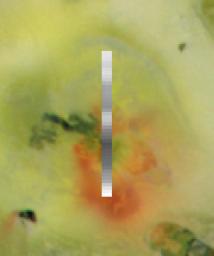
|
Culann Patera/NIMS
- Click the image above for a larger view
- Full-Res JPEG (504 x 604) (16.8 kB)
- Full-Res TIFF (504 x 604) (478.6 kB)
Caption:
The Culann Patera volcano on Jupiter's moon Io was observed by the near-infrared mapping spectrometer instrument onboard NASA's Galileo spacecraft during its Io flyby on November 25, 1999. The instrument obtained spectral data over part of Culann. The spectra were made into a map of the relative amounts of sulfur dioxide frost, superimposed on an image taken by Galileo's camera in July 1999. In the map, white represents more sulfur dioxide. The image is about 340 kilometers (210 miles) across. The red deposits around Culann and many other volcanoes on Io are thought to be short-chain sulfur molecules (S3 and S4). The spectrometer data shows that the red deposits coincide with enhanced concentrations of sulfur dioxide frost. This is interpreted as being caused by a plume that produced both sulfur and sulfur dioxide, depositing both materials in the same locations.
Background Info:
The Jet Propulsion Laboratory, Pasadena, CA manages the mission for NASA's Office of Space Science, Washington, DC. JPL is a division of the California Institute of Technology, Pasadena, CA.
This image and other images and data received from Galileo are posted on the Galileo mission home page at http://solarsystem.nasa.gov/galileo/ . Background information and educational context for the images can be found at http://galileo.jpl.nasa.gov/gallery/io.cfm .
Cataloging Keywords:
| Name | Value | Additional Values |
|---|---|---|
| Target | Io | |
| System | Jupiter | |
| Target Type | Satellite | |
| Mission | Galileo | |
| Instrument Host | Galileo Orbiter | |
| Host Type | Orbiter | |
| Instrument | Near-Infrared Mapping Spectrometer (NIMS) | |
| Detector | ||
| Extra Keywords | Color, Infrared, Map, Plume, Volcano | |
| Acquisition Date | ||
| Release Date | 2000-05-18 | |
| Date in Caption | 1999-11-25 | |
| Image Credit | NASA/JPL | |
| Source | photojournal.jpl.nasa.gov/catalog/PIA02544 | |
| Identifier | PIA02544 | |
